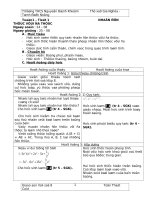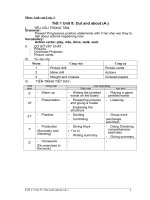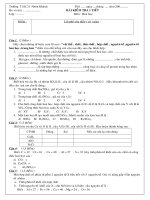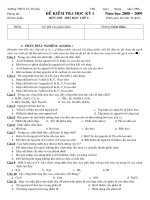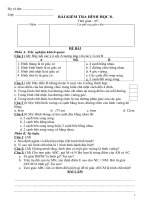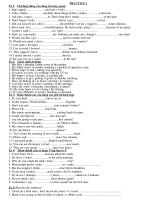- Trang chủ >>
- Đề thi >>
- Đề thi lớp 8
Grade 8 module 1 student edition (1)
Bạn đang xem bản rút gọn của tài liệu. Xem và tải ngay bản đầy đủ của tài liệu tại đây (955.64 KB, 52 trang )
Lesson 1
NYS COMMON CORE MATHEMATICS CURRICULUM
8•1
Lesson 1: Exponential Notation
Classwork
𝟗 𝟒
𝟓𝟔 means 𝟓 × 𝟓 × 𝟓 × 𝟓 × 𝟓 × 𝟓 and � � means
𝟕
𝟗
𝟕
×
𝟗
𝟕
×
𝟗
𝟕
𝟗
× .
𝟕
You have seen this kind of notation before, it is called exponential notation. In general, for any number 𝒙 and any
positive integer 𝒏,
𝒙𝒏 = (𝒙
∙ 𝒙 ⋯��
𝒙)
�����
𝒏 𝒕𝒊𝒎𝒆𝒔
𝒏
The number 𝒙 is called 𝒙 raised to the 𝒏-th power, 𝒏 is the exponent of 𝒙 in 𝒙𝒏 and 𝒙 is the base of 𝒙𝒏 .
Exercise 1
Exercise 6
4 ���
��
⋯×
��
4=
7
7
× ⋯× =
��
2 �����
2
Exercise 2
Exercise 7
3.6����
��
⋯ ×���
3.6 = 3.647
(−13) × ⋯ × (−13) =
�������������
Exercise 3
Exercise 8
(−11.63)
× ⋯ × (−11.63) =
�����������������
1
1
�− � × ⋯ × �− � =
���������������
14
14
Exercise 4
Exercise 9
12 �
��
���
⋯×
���
12 = 1215
𝑥 ∙ 𝑥⋯𝑥 =
�����
Exercise 5
Exercise 10
(−5)
× ⋯ × (−5) =
�����������
_______𝑡𝑖𝑚𝑒𝑠
7 𝑡𝑖𝑚𝑒𝑠
21 𝑡𝑖𝑚𝑒𝑠
_______ 𝑡𝑖𝑚𝑒𝑠
6 𝑡𝑖𝑚𝑒𝑠
34 𝑡𝑖𝑚𝑒𝑠
10 𝑡𝑖𝑚𝑒𝑠
185 𝑡𝑖𝑚𝑒𝑠
_______𝑡𝑖𝑚𝑒𝑠
𝑥 ∙ 𝑥 ⋯ 𝑥 = 𝑥𝑛
�����
10 𝑡𝑖𝑚𝑒𝑠
Lesson 1:
Date:
© 2013 Common Core, Inc. Some rights reserved. commoncore.org
Exponential Notation
7/24/13
S.1
This work is licensed under a
Creative Commons Attribution-NonCommercial-ShareAlike 3.0 Unported License.
NYS COMMON CORE MATHEMATICS CURRICULUM
Lesson 1
8•1
Exercise 11
Will these products be positive or negative? How do you know?
(−1)
× (−1) × ⋯ × (−1) = (−1)12
�����������������
12 𝑡𝑖𝑚𝑒𝑠
(−1) × (−1) × ⋯ × (−1) = (−1)13
�����������������
13 𝑡𝑖𝑚𝑒𝑠
Exercise 12
Is it necessary to do all of the calculations to determine the sign of the product? Why or why not?
(−5) × (−5) × ⋯ × (−5) = (−5)95
�����������������
95 𝑡𝑖𝑚𝑒𝑠
(−1.8)
× (−1.8) × ⋯ × (−1.8) = (−1.8)122
���������������������
122 𝑡𝑖𝑚𝑒𝑠
Lesson 1:
Date:
© 2013 Common Core, Inc. Some rights reserved. commoncore.org
Exponential Notation
7/24/13
S.2
This work is licensed under a
Creative Commons Attribution-NonCommercial-ShareAlike 3.0 Unported License.
Lesson 1
NYS COMMON CORE MATHEMATICS CURRICULUM
8•1
Exercise 13
Fill in the blanks about whether the number is positive or negative.
If 𝑛 is a positive even number, then (−55)𝑛 is __________________________.
If 𝑛 is a positive odd number, then (−72.4)𝑛 is __________________________.
Exercise 14
Josie says that (−15)
× ⋯ × (−15) = −156 . Is she correct? How do you know?
�������������
6 𝑡𝑖𝑚𝑒𝑠
Lesson 1:
Date:
© 2013 Common Core, Inc. Some rights reserved. commoncore.org
Exponential Notation
7/24/13
S.3
This work is licensed under a
Creative Commons Attribution-NonCommercial-ShareAlike 3.0 Unported License.
Lesson 1
NYS COMMON CORE MATHEMATICS CURRICULUM
8•1
Problem Set
1.
Use what you know about exponential notation to complete the expressions below.
(−5) × ⋯ × (−5) =
�����������
3.7����
��
⋯ ×���
3.7 = 3.719
7 ���
��
⋯×
��
7 = 745
6 ���
��
⋯×
��
6=
4.3����
��
⋯ ×���
4.3 =
(−1.1)
(−1.1)
⋯ ×��
��
�������
���� =
_____ 𝑡𝑖𝑚𝑒𝑠
17 𝑡𝑖𝑚𝑒𝑠
4 𝑡𝑖𝑚𝑒𝑠
_____ 𝑡𝑖𝑚𝑒𝑠
13 𝑡𝑖𝑚𝑒𝑠
9 𝑡𝑖𝑚𝑒𝑠
11
11
11 𝑥
�− � × ⋯ × �− � = �− �
���������������
5
5
5
2
2
� � × ⋯× � � =
���������
3
3
19 𝑡𝑖𝑚𝑒𝑠
_____ 𝑡𝑖𝑚𝑒𝑠
(−12)
× ⋯ × (−12) = (−12)15
�������������
𝑎 ×���
��
⋯×
��
𝑎=
𝑚 𝑡𝑖𝑚𝑒𝑠
_____ 𝑡𝑖𝑚𝑒𝑠
2.
Write an expression with (−1) as its base that will produce a positive product.
3.
Write an expression with (−1) as its base that will produce a negative product.
4.
Rewrite each number in exponential notation using 2 as the base.
5.
6.
8=
64 =
16 =
128 =
Tim wrote 16 as (−2)4 . Is he correct?
32 =
256 =
Could −2 be used as a base to rewrite 32? 64? Why or why not?
Lesson 1:
Date:
© 2013 Common Core, Inc. Some rights reserved. commoncore.org
Exponential Notation
7/24/13
S.4
This work is licensed under a
Creative Commons Attribution-NonCommercial-ShareAlike 3.0 Unported License.
Lesson 2
NYS COMMON CORE MATHEMATICS CURRICULUM
8•1
Lesson 2: Multiplication of Numbers in Exponential Form
Classwork
In general, if 𝑥 is any number and 𝑚, 𝑛 are positive integers, then
𝑥 𝑚 ∙ 𝑥 𝑛 = 𝑥 𝑚+𝑛
because
(𝑥��
(𝑥��
(𝑥��
𝑥𝑚 × 𝑥𝑛 = �
⋯�𝑥)
⋯�𝑥)
⋯�𝑥)
��
�= �
� = 𝑥 𝑚+𝑛
𝑚 𝑡𝑖𝑚𝑒𝑠
𝑛 𝑡𝑖𝑚𝑒𝑠
𝑚+𝑛 𝑡𝑖𝑚𝑒𝑠
Exercise 1
Exercise 5
1423 × 148 =
Let 𝑎 be a number.
Exercise 2
Exercise 6
(−72)10 × (−72)13 =
Let f be a number.
Exercise 3
Exercise 7
594 × 578 =
Let 𝑏 be a number.
Exercise 4
Exercise 8
(−𝟑)𝟗 × (−𝟑)𝟓 =
Let 𝑥 be a positive integer. If (−3)9 × (−3) 𝑥 = (−3)14 ,
what is 𝑥?
𝑎23 ∙ 𝑎8 =
𝑓 10 ∙ 𝑓 13 =
𝑏 94 ∙ 𝑏 78 =
Lesson 2:
Date:
© 2013 Common Core, Inc. Some rights reserved. commoncore.org
Multiplication of Numbers in Exponential Form
7/24/13
This work is licensed under a
Creative Commons Attribution-NonCommercial-ShareAlike 3.0 Unported License.
S.5
Lesson 2
NYS COMMON CORE MATHEMATICS CURRICULUM
8•1
What would happen if there were more terms with the same base? Write an equivalent expression for each problem.
Exercise 9
Exercise 10
94 × 96 × 913 =
23 × 25 × 27 × 29 =
Can the following expressions be simplified? If so, write an equivalent expression. If not, explain why not.
Exercise 11
Exercise 14
65 × 49 × 43 × 614 =
24 × 82 = 24 × 26 =
Exercise 12
Exercise 15
(−4)2 ∙ 175 ∙ (−4)3 ∙ 177 =
37 × 9 =
Exercise 13
Exercise 16
152 ∙ 72 ∙ 15 ∙ 74 =
54 × 211 =
Exercise 17
Let 𝑥 be a number. Simplify the expression of the following number:
(2𝑥 3 )(17𝑥 7 ) =
Exercise 18
Let 𝑎 and 𝑏 be numbers. Use the distributive law to simplify the expression of the following number:
𝑎(𝑎 + 𝑏) =
Lesson 2:
Date:
© 2013 Common Core, Inc. Some rights reserved. commoncore.org
Multiplication of Numbers in Exponential Form
7/24/13
This work is licensed under a
Creative Commons Attribution-NonCommercial-ShareAlike 3.0 Unported License.
S.6
Lesson 2
NYS COMMON CORE MATHEMATICS CURRICULUM
8•1
Exercise 19
Let 𝑎 and 𝑏 be numbers. Use the distributive law to simplify the expression of the following number:
𝑏(𝑎 + 𝑏) =
Exercise 20
Let 𝑎 and 𝑏 be numbers. Use the distributive law to simplify the expression of the following number:
(𝑎 + 𝑏)(𝑎 + 𝑏) =
In general, if 𝑥 is nonzero and 𝑚, 𝑛 are positive integers, then
𝑥𝑚
= 𝑥 𝑚−𝑛
𝑥𝑛
𝑖𝑓 𝑚 > 𝑛
Exercise 21
Exercise 23
79
=
76
8 9
� �
5 =
8 2
� �
5
Exercise 22
Exercise 24
(−5)16
=
(−5)7
135
=
134
Lesson 2:
Date:
© 2013 Common Core, Inc. Some rights reserved. commoncore.org
Multiplication of Numbers in Exponential Form
7/24/13
This work is licensed under a
Creative Commons Attribution-NonCommercial-ShareAlike 3.0 Unported License.
S.7
Lesson 2
NYS COMMON CORE MATHEMATICS CURRICULUM
8•1
Exercise 25
Let 𝑎, 𝑏 be nonzero numbers. What is the following number?
𝑎 9
� �
𝑏 =
𝑎 2
� �
𝑏
Exercise 26
Let 𝑥 be a nonzero number. What is the following number?
𝑥5
=
𝑥4
Can the following expressions be simplified? If yes, write an equivalent expression for each problem. If not, explain why
not.
Exercise 27
Lesson 29
27 2 7
=
=
42 24
3 5 ∙ 28
=
3 2 ∙ 23
Exercise 28
Lesson 30
323 323
= 3 =
27
3
(−2)7 ∙ 955
=
(−2)5 ∙ 954
Lesson 2:
Date:
© 2013 Common Core, Inc. Some rights reserved. commoncore.org
Multiplication of Numbers in Exponential Form
7/24/13
This work is licensed under a
Creative Commons Attribution-NonCommercial-ShareAlike 3.0 Unported License.
S.8
Lesson 2
NYS COMMON CORE MATHEMATICS CURRICULUM
8•1
Exercise 31
Let 𝑥 be a number. Simplify the expression of each of the following numbers:
1.
2.
3.
5
𝑥3
(3𝑥 8 ) =
𝑥3
(−4𝑥 6 ) =
𝑥3
(11𝑥 4 ) =
5
5
Exercise 32
Anne used an online calculator to multiply 2,000,000,000 × 2, 000, 000, 000, 000. The answer showed up on the
calculator as 4e + 21, as shown below. Is the answer on the calculator correct? How do you know?
.
Lesson 2:
Date:
© 2013 Common Core, Inc. Some rights reserved. commoncore.org
Multiplication of Numbers in Exponential Form
7/24/13
This work is licensed under a
Creative Commons Attribution-NonCommercial-ShareAlike 3.0 Unported License.
S.9
Lesson 2
NYS COMMON CORE MATHEMATICS CURRICULUM
8•1
Problem Set
1.
2
A certain ball is dropped from a height of 𝑥 feet, it always bounces up to 𝑥 feet. Suppose the ball is dropped from
th
3
10 feet and is caught exactly when it touches the ground after the 30 bounce, what is the total distance traveled by
the ball? Express your answer in exponential notation.
Bounce
Computation of Distance
Traveled in Previous
Bounce
Total Distance Traveled (in feet)
1
2
3
4
30
𝑛
th
2.
If the same ball is dropped from 10 feet and is caught exactly at the highest point after the 25 bounce, what is the
total distance traveled by the ball? Use what you learned from the last problem.
3.
Let 𝑎 and 𝑏 be numbers and 𝑏 ≠ 0, and let 𝑚 and 𝑛 be positive integers. Simplify each of the following expressions
as much as possible:
(−19)5 ∙ (−19)11 =
2.75 × 2.73 =
710
=
73
1 2 1 15
� � ∙� � =
5
5
9 𝑚
9 𝑛
�− � ∙ �− � =
7
7
𝑎𝑏 3
=
𝑏2
4.
Let the dimensions of a rectangle be (4 × (871209)5 + 3 × 49762105) ft. by (7 × (871209)3 − (49762105)4 ) ft.
Determine the area of the rectangle. No need to expand all the powers.
5.
A rectangular area of land is being sold off in smaller pieces. The total area of the land is 215 square miles. The
pieces being sold are 83 square miles in size. How many smaller pieces of land can be sold at the stated size?
Compute the actual number of pieces.
Lesson 2:
Date:
© 2013 Common Core, Inc. Some rights reserved. commoncore.org
Multiplication of Numbers in Exponential Form
7/24/13
This work is licensed under a
Creative Commons Attribution-NonCommercial-ShareAlike 3.0 Unported License.
S.10
Lesson 3
NYS COMMON CORE MATHEMATICS CURRICULUM
8•1
Lesson 3: Numbers in Exponential Form Raised to a Power
Classwork
For any number 𝑥 and any positive integers 𝑚 and 𝑛,
because
(𝑥 𝑚 )𝑛 = 𝑥 𝑚𝑛
(𝑥 𝑚 )𝑛 = �������
(𝑥 ∙ 𝑥 ⋯ 𝑥)𝑛
𝑚 𝑡𝑖𝑚𝑒𝑠
(𝑥 ���
(𝑥 ���
= ��
∙ 𝑥 ⋯��
𝑥) × ⋯ × ��
∙ 𝑥 ⋯��
𝑥)
=𝑥
𝑚 𝑡𝑖𝑚𝑒𝑠
𝑚𝑛
𝑚 𝑡𝑖𝑚𝑒𝑠
Exercise 1
Exercise 3
(153 )9 =
(3.417 )4 =
Exercise 2
Exercise 4
((−2)5 )8 =
Let 𝑠 be a number.
(𝑛 𝑡𝑖𝑚𝑒𝑠)
(𝑠17 )4 =
Exercise 5
Sarah wrote that (35 )7 = 312 . Correct her mistake. Write an exponential expression using a base of 3 and exponents of
5, 7, and 12 that would make her answer correct.
Exercise 6
A number 𝑦 satisfies 𝑦 24 − 256 = 0. What equation does the number 𝑥 = 𝑦 4 satisfy?
Lesson 3:
Date:
© 2013 Common Core, Inc. Some rights reserved. commoncore.org
Numbers in Exponential Form Raised to a Power
7/24/13
This work is licensed under a
Creative Commons Attribution-NonCommercial-ShareAlike 3.0 Unported License.
S.11
Lesson 3
NYS COMMON CORE MATHEMATICS CURRICULUM
For any numbers 𝑥 and 𝑦, and positive integer 𝑛,
8•1
(𝑥𝑦)𝑛 = 𝑥 𝑛 𝑦 𝑛
because
(𝑥𝑦)
(𝑥𝑦)𝑛 = ��
⋯ (𝑥𝑦)
����
���
𝑛 𝑡𝑖𝑚𝑒𝑠
(𝑥 ���
= ��
∙ 𝑥 ⋯��
𝑥) ∙ (𝑦
∙ 𝑦 ⋯��
𝑦)
�����
𝑛 𝑡𝑖𝑚𝑒𝑠
𝑛 𝑛
=𝑥 𝑦
𝑛 𝑡𝑖𝑚𝑒𝑠
Exercise 7
Exercise 10
(11 × 4)9 =
Let 𝑥 be a number.
Exercise 8
Exercise 11
(32 × 74 )5 =
Let 𝑥 and 𝑦 be numbers.
Exercise 9
Exercise 12
Let 𝑎, 𝑏, and 𝑐 be numbers.
Let 𝑎, 𝑏, and 𝑐 be numbers.
(5𝑥)7 =
(5𝑥𝑦 2 )7 =
(32 𝑎4 )5 =
(𝑎2 𝑏𝑐 3 )4 =
Exercise 13
Let 𝑥 and 𝑦 be numbers, 𝑦 ≠ 0, and let 𝑛 be a positive integer. How is �
Lesson 3:
Date:
© 2013 Common Core, Inc. Some rights reserved. commoncore.org
𝑥 𝑛
𝑦
� related to 𝑥 𝑛 and 𝑦 𝑛 ?
Numbers in Exponential Form Raised to a Power
7/24/13
This work is licensed under a
Creative Commons Attribution-NonCommercial-ShareAlike 3.0 Unported License.
S.12
Lesson 3
NYS COMMON CORE MATHEMATICS CURRICULUM
8•1
Problem Set
1.
2.
3.
Show (prove) in detail why (2 ∙ 3 ∙ 4)4 = 24 34 44 .
Show (prove) in detail why (𝑥𝑦𝑧)4 = 𝑥 4 𝑦 4 𝑧 4 for any numbers 𝑥, 𝑦, 𝑧.
Show (prove) in detail why (𝑥𝑦𝑧)𝑛 = 𝑥 𝑛 𝑦 𝑛 𝑧 𝑛 for any numbers 𝑥, 𝑦, 𝑧, and for any positive integer 𝑛.
Lesson 3:
Date:
© 2013 Common Core, Inc. Some rights reserved. commoncore.org
Numbers in Exponential Form Raised to a Power
7/24/13
This work is licensed under a
Creative Commons Attribution-NonCommercial-ShareAlike 3.0 Unported License.
S.13
Lesson 4
NYS COMMON CORE MATHEMATICS CURRICULUM
8•1
Lesson 4: Numbers Raised to the Zeroth Power
Classwork
For any numbers 𝑥, 𝑦, and any positive integers 𝑚, 𝑛, the following holds:
𝑥 𝑚 ∙ 𝑥 𝑛 = 𝑥 𝑚+𝑛
(𝑥 𝑚 )𝑛 = 𝑥 𝑚𝑛
(1)
(2)
(𝑥𝑦)𝑛 = 𝑥 𝑛 𝑦 𝑛
(3)
Definition: ___________________________________________________________________________
Exercise 1
List all possible cases of whole numbers 𝑚 and 𝑛 for identity (1). More precisely, when 𝑚 > 0 and 𝑛 > 0, we already
know that (1) is correct. What are the other possible cases of 𝑚 and 𝑛 for which (1) is yet to be verified?
Exercise 2
Check that equation (1) is correct for each of the cases listed in Exercise 1.
Lesson 4:
Date:
© 2013 Common Core, Inc. Some rights reserved. commoncore.org
Numbers Raised to the Zeroth Power
7/24/13
S.14
This work is licensed under a
Creative Commons Attribution-NonCommercial-ShareAlike 3.0 Unported License.
NYS COMMON CORE MATHEMATICS CURRICULUM
Lesson 4
8•1
Exercise 3
Do the same with equation (2) by checking it case-by-case.
Exercise 4
Do the same with equation (3) by checking it case-by-case.
Exercise 5
Write the expanded form of 8,374 using the exponential notation.
Exercise 6
Write the expanded form of 6,985,062 using the exponential notation.
Lesson 4:
Date:
© 2013 Common Core, Inc. Some rights reserved. commoncore.org
Numbers Raised to the Zeroth Power
7/24/13
S.15
This work is licensed under a
Creative Commons Attribution-NonCommercial-ShareAlike 3.0 Unported License.
Lesson 4
NYS COMMON CORE MATHEMATICS CURRICULUM
8•1
Problem Set
Let 𝑥, 𝑦 be numbers (𝑥, 𝑦 ≠ 0). Simplify each of the following expressions of numbers.
2.
1.
12
𝑦
=
𝑦12
915 ∙
1
=
915
4.
3.
(7(123456.789)4 )0
=
22 ∙
1 5 1
∙2 ∙ 2 =
25
2
5.
𝑥 41 𝑦15
∙
=
𝑦15 𝑥 41
Lesson 4:
Date:
© 2013 Common Core, Inc. Some rights reserved. commoncore.org
Numbers Raised to the Zeroth Power
7/24/13
S.16
This work is licensed under a
Creative Commons Attribution-NonCommercial-ShareAlike 3.0 Unported License.
Lesson 5
NYS COMMON CORE MATHEMATICS CURRICULUM
8•1
Lesson 5: Negative Exponents and the Laws of Exponents
Classwork
Definition: For any positive number 𝑥 and for any positive integer 𝑛, we define 𝑥−𝑛 =
Note that this definition of negative exponents says 𝑥−1 is just the reciprocal
As a consequence of the definition, for a positive 𝑥 and all integers 𝑏, we get
𝑥−𝑏 =
Exercise 1
Verify the general statement 𝑥 −𝑏 =
1
𝑥𝑏
1
𝑥
of 𝑥.
1
𝑥𝑛
.
1
𝑥𝑏
for 𝑥 = 3 and 𝑏 = −5.
Exercise 2
What is the value of (3 × 10−2 )?
Lesson 5:
Date:
© 2013 Common Core, Inc. Some rights reserved. commoncore.org
Negative Exponents and the Laws of Exponents
7/24/13
This work is licensed under a
Creative Commons Attribution-NonCommercial-ShareAlike 3.0 Unported License.
S.17
Lesson 5
NYS COMMON CORE MATHEMATICS CURRICULUM
8•1
Exercise 3
What is the value of (3 × 10−5 )?
Exercise 4
Write the complete expanded form of the decimal 4.728 in exponential notation.
For Exercises 5–10, write an equivalent expression, in exponential notation, to the one given and simplify as much as
possible.
Exercise 5
Exercise 8
5−3 =
Let 𝑥 be a nonzero number.
Exercise 6
Exercise 9
1
=
89
Let 𝑥 be a nonzero number.
Exercise 7
Exercise 10
3 ∙ 2−4 =
Let 𝑥, 𝑦 be two nonzero numbers.
𝑥 −3 =
1
=
𝑥9
𝑥𝑦 −4 =
Lesson 5:
Date:
© 2013 Common Core, Inc. Some rights reserved. commoncore.org
Negative Exponents and the Laws of Exponents
7/24/13
This work is licensed under a
Creative Commons Attribution-NonCommercial-ShareAlike 3.0 Unported License.
S.18
Lesson 5
NYS COMMON CORE MATHEMATICS CURRICULUM
8•1
We accept that for positive numbers 𝑥, 𝑦 and all integers 𝑎 and 𝑏,
𝑥 𝑎 ∙ 𝑥 𝑏 = 𝑥 𝑎+𝑏
𝑎
�𝑥 𝑏 � = 𝑥 𝑎𝑏
(𝑥𝑦)𝑎 = 𝑥 𝑎 𝑦 𝑎
We claim:
𝑥𝑎
𝑥𝑏
𝑥 𝑎
𝑦
= 𝑥 𝑎−𝑏
� � =
𝑥𝑎
𝑦𝑎
for all integers 𝑎, 𝑏
for any integer 𝑎
Exercise 11
Exercise 12
192
=
195
1716
=
17−3
Exercise 13
If we let 𝑏 = −1 in (11), 𝑎 be any integer, and 𝑦 be any positive number, what do we get?
Lesson 5:
Date:
© 2013 Common Core, Inc. Some rights reserved. commoncore.org
Negative Exponents and the Laws of Exponents
7/24/13
This work is licensed under a
Creative Commons Attribution-NonCommercial-ShareAlike 3.0 Unported License.
S.19
Lesson 5
NYS COMMON CORE MATHEMATICS CURRICULUM
8•1
Exercise 14
Show directly that
7 −4
�5�
=
7−4
5−4
.
Lesson 5:
Date:
© 2013 Common Core, Inc. Some rights reserved. commoncore.org
Negative Exponents and the Laws of Exponents
7/24/13
This work is licensed under a
Creative Commons Attribution-NonCommercial-ShareAlike 3.0 Unported License.
S.20
Lesson 5
NYS COMMON CORE MATHEMATICS CURRICULUM
8•1
Problem Set
1.
Compute: 33 × 32 × 31 × 30 × 3−1 × 3−2 =
Compute: 52 × 510 × 58 × 50 × 5−10 × 5−8 =
2.
Compute. For a nonzero number, 𝑎: 𝑎𝑚 × 𝑎𝑛 × 𝑎𝑙 × 𝑎−𝑛 × 𝑎−𝑚 × 𝑎 −𝑙 × 𝑎0 =
Without using (10), show directly that (17.6−1 )8 = 17.6−8 .
3.
Without using (10), show (prove) that for any whole number 𝑛 and any positive number 𝑦, (𝑦 −1 )𝑛 = 𝑦 −𝑛 .
4.
Show directly without using (13) that
Lesson 5:
Date:
© 2013 Common Core, Inc. Some rights reserved. commoncore.org
2.8−5
2.87
= 2.8−12 .
Negative Exponents and the Laws of Exponents
7/24/13
This work is licensed under a
Creative Commons Attribution-NonCommercial-ShareAlike 3.0 Unported License.
S.21
Lesson 6
NYS COMMON CORE MATHEMATICS CURRICULUM
8•1
Lesson 6: Proofs of Laws of Exponents
Classwork
The Laws of Exponents
For 𝑥, 𝑦 > 0, and all integers 𝑎, 𝑏, the following holds:
𝑥 𝑎 ∙ 𝑥 𝑏 = 𝑥 𝑎+𝑏
𝑎
�𝑥 𝑏 � = 𝑥 𝑎𝑏
(𝑥𝑦)𝑎 = 𝑥 𝑎 𝑦 𝑎
Facts we will use to prove (11):
(A) (11) is already known to be true when the integers 𝑎 and 𝑏 satisfy 𝑎 ≥ 0, 𝑏 ≥ 0.
(B) 𝑥 −𝑚 =
(C)
1 𝑚
1
𝑥𝑚
1
for any whole number 𝑚
�𝑥� = 𝑥 𝑚 for any whole number 𝑚
Exercise 1
Show that (C) is implied by equation (5) of Lesson 4 when 𝑚 > 0, and explain why (C) continues to hold even when
𝑚 = 0.
Lesson 6:
Date:
© 2013 Common Core, Inc. Some rights reserved. commoncore.org
Proofs of Laws of Exponents
7/24/13
S.22
This work is licensed under a
Creative Commons Attribution-NonCommercial-ShareAlike 3.0 Unported License.
NYS COMMON CORE MATHEMATICS CURRICULUM
Lesson 6
8•1
Exercise 2
Show that (B) is in fact a special case of (11) by rewriting it as (𝑥 𝑚 )−1 = 𝑥 (−1)𝑚 for any whole number 𝑚, so that if
𝑏 = 𝑚 (where 𝑚 is a whole number) and 𝑎 = −1, (11) becomes (B).
Exercise 3
Show that (C) is a special case of (11) by rewriting (C) as (𝑥 −1 )𝑚 = 𝑥 𝑚(−1) for any whole number 𝑚. Thus, (C) is the
special case of (11) when 𝑏 = −1 and 𝑎 = 𝑚, where 𝑚 is a whole number.
Lesson 6:
Date:
© 2013 Common Core, Inc. Some rights reserved. commoncore.org
Proofs of Laws of Exponents
7/24/13
S.23
This work is licensed under a
Creative Commons Attribution-NonCommercial-ShareAlike 3.0 Unported License.
NYS COMMON CORE MATHEMATICS CURRICULUM
Lesson 6
8•1
Exercise 4
Proof of Case (iii): Show that when 𝑎 < 0 and 𝑏 ≥ 0, (𝑥 𝑏 )𝑎 = 𝑥 𝑎𝑏 is still valid. Let 𝑎 = −𝑐 for some positive integer 𝑐.
Show that the left side and right sides of (𝑥 𝑏 )𝑎 = 𝑥 𝑎𝑏 are equal.
Lesson 6:
Date:
© 2013 Common Core, Inc. Some rights reserved. commoncore.org
Proofs of Laws of Exponents
7/24/13
S.24
This work is licensed under a
Creative Commons Attribution-NonCommercial-ShareAlike 3.0 Unported License.
Lesson 6
NYS COMMON CORE MATHEMATICS CURRICULUM
8•1
Problem Set
1.
You sent a photo of you and your family on vacation to seven Facebook friends. If each of them sends it to five of
their friends, and each of those friends sends it to five of their friends, and those friends send it to five more, how
many people (not counting yourself) will see your photo? No friend received the photo twice. Express your answer
in exponential notation.
# of New People to View Your Photo
2.
Show directly, without using (11), that (1.27−36 )85 = 1.27−36∙85 .
3.
Show directly that � �
4.
5.
2 −127
13
2 −56
13
∙� �
Total # of People to View Your Photo
2 −183
.
13
=� �
Prove for any positive number 𝑥, 𝑥 −127 ∙ 𝑥 −56 = 𝑥 −183 .
Prove for any positive number 𝑥, 𝑥 −𝑚 ∙ 𝑥 −𝑛 = 𝑥 −𝑚−𝑛 for positive integers 𝑚 and 𝑛.
6.
Which of the preceding four problems did you find easiest to do? Explain.
7.
Use the properties of exponents to write an equivalent expression that is a product of distinct primes, each raised to
an integer power.
Lesson 6:
Date:
© 2013 Common Core, Inc. Some rights reserved. commoncore.org
Proofs of Laws of Exponents
7/24/13
S.25
This work is licensed under a
Creative Commons Attribution-NonCommercial-ShareAlike 3.0 Unported License.
